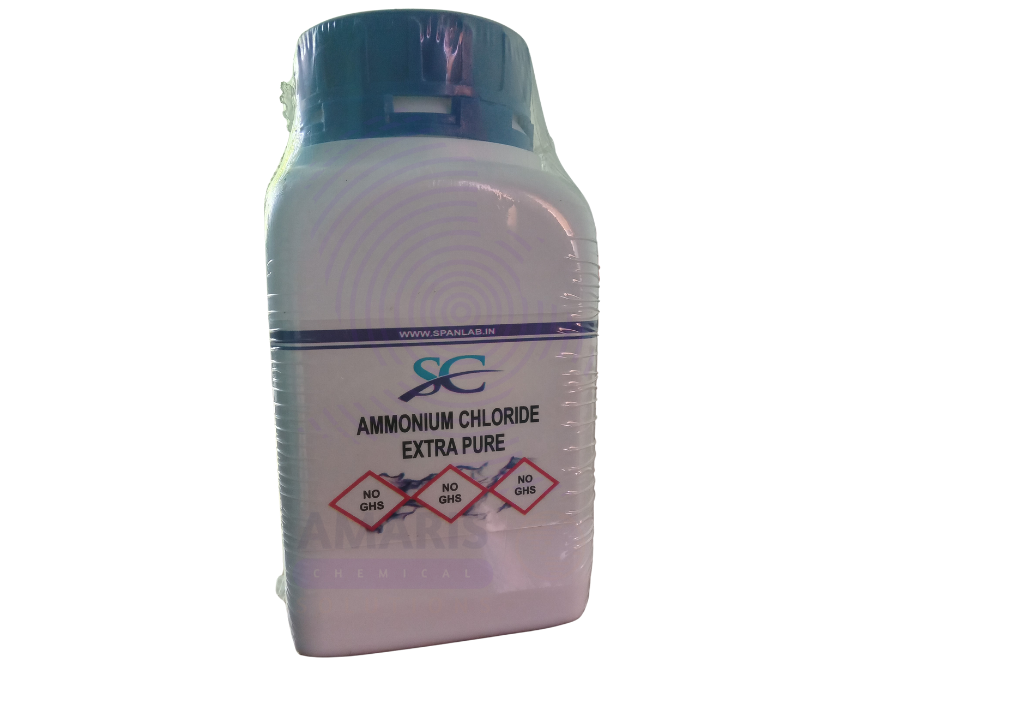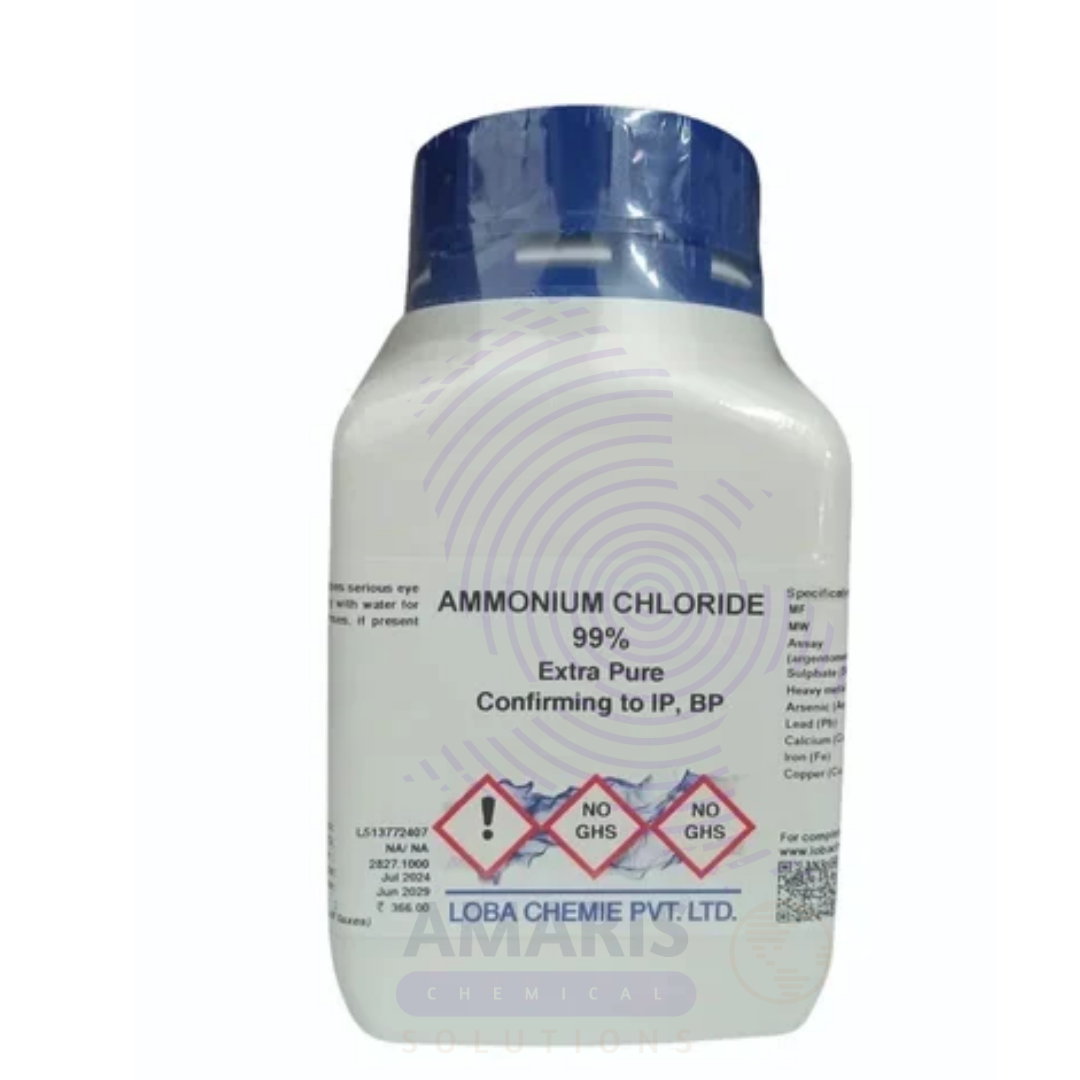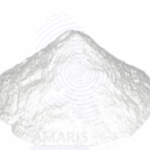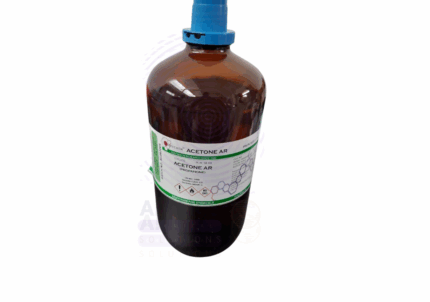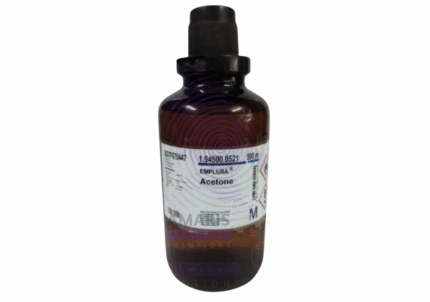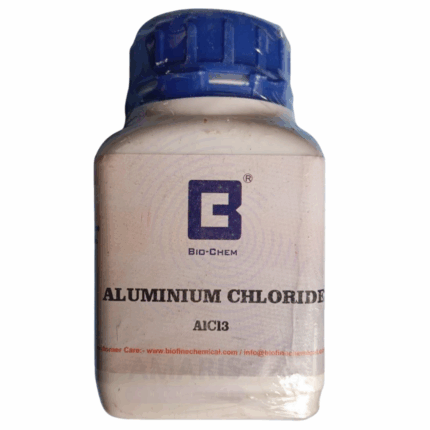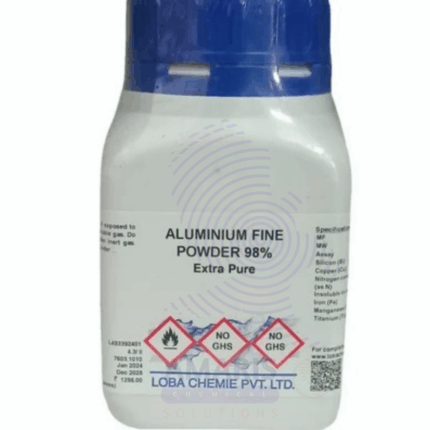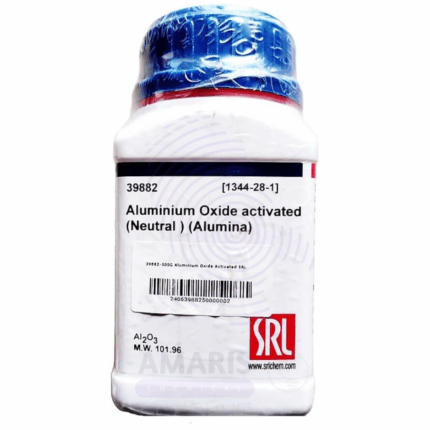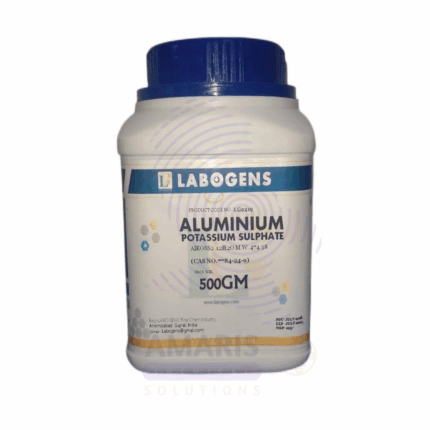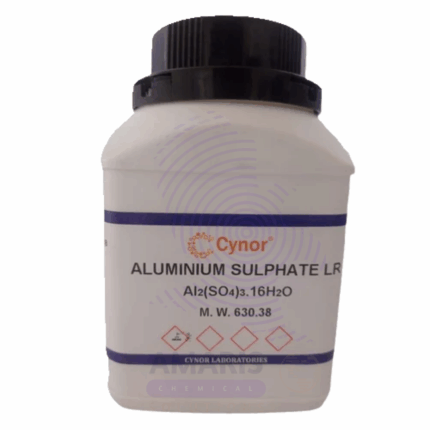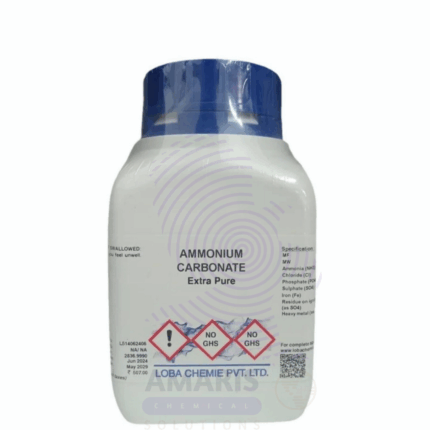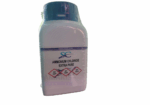
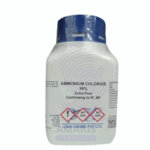
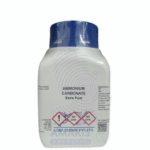
Ammonium Chloride Extra Pure
$ 19.00 Original price was: $ 19.00.$ 18.65Current price is: $ 18.65.
Ammonium Chloride Extra Pure is a high-purity, white crystalline salt widely used in laboratory chemistry as a source of ammonium ions and chloride ions for analytical, inorganic, and biochemical applications. It plays a key role in preparing buffer solutions, especially in conjunction with ammonia, and is commonly used in qualitative analysis, electrochemical studies, and metal treatment experiments. In addition, it serves as a reagent in synthesis reactions and as a nitrogen source in microbial culture media. The extra pure grade ensures high consistency and minimal contaminants, making it suitable for precise and sensitive laboratory work. It should be stored in a cool, dry place in well-sealed containers to maintain stability and prevent moisture absorption.
Ammonium Chloride Extra Pure
Primary Uses
- Reagent in Qualitative Inorganic Analysis
- Used to suppress the ionization of weak bases (e.g., NH₄OH) and control precipitation in cation group analysis.
- Buffer Component (Ammonium Buffer Systems)
- Combined with ammonia to maintain mildly acidic pH in biochemical and analytical buffer solutions.
- Reagent in Metallurgical Experiments
- Acts as a flux in lab-scale metal cleaning and preparation, especially for tin, zinc, or soldering studies.
- Source of Ammonium Ions in Synthesis
- Supplies NH₄⁺ in preparing other ammonium salts, complex metal compounds, or during redox reactions.
- Educational Demonstrations in Sublimation and Thermal Reactions
- Shows reversible sublimation when heated, ideal for teaching volatility and equilibrium concepts.
Secondary Uses
- Electrolyte in Conductivity and Galvanic Cell Experiments
- Serves as a chloride-based ionic conductor in salt bridges or simple electrochemical setups.
- Nitrogen Source in Microbial Growth Media
- Occasionally used as a nitrogen supplement in lab-prepared culture media for microbial studies.
- Reagent in Le Chatelier’s Principle Demonstrations
- Shows shifts in chemical equilibrium when heated (e.g., NH₄Cl ⇌ NH₃ + HCl gas), useful in teaching gas-phase equilibrium.
- Corrosion Testing & Surface Reaction Studies
- Used to simulate chloride-induced corrosion in environmental or material science labs.
- Controlled pH Experiments in Soil and Water Chemistry
- Applied in modeling ion exchange, soil acidification, or pollutant transport studies.
| PACK SIZE |
500 grams Plastic Tin |
|---|
1. Basic Identification Attributes
- Chemical Name: Ammonium Chloride
- CAS Number: 12125-02-9
- HS Code: 28271000 (Ammonium chloride)
- Molecular Formula: NH₄Cl
- Synonyms:
- Sal ammoniac
- Ammonium muriate
- Ammonii chloridum
- Ammonium salt of hydrochloric acid
2. Physical & Chemical Properties
- Physical State: Solid (crystalline powder or granules)
- Color & Odor: White, odorless crystals
- Boiling Point: Sublimes at ~520°C
- Melting Point: ~338°C (sublimes, no liquid phase at atmospheric pressure)
- Density/Specific Gravity: ~1.527 g/cm³
- Solubility:
- Water: Freely soluble (~29.7 g/100 mL at 25°C)
- Alcohol: Slightly soluble
- pH Level: ~4.5–6.0 (in 5% aqueous solution)
- Vapor Pressure: Negligible (solid)
- Flash Point: Not flammable
- Autoignition Temperature: Not applicable
- Viscosity: Not applicable
3. Safety & Hazard Attributes
- Hazard Class (GHS):
- Eye Irritation (Category 2A)
- Acute Toxicity – Oral & Inhalation (Category 4)
- NFPA Ratings:
- Health: 2
- Flammability: 0
- Reactivity: 0
- Exposure Limits:
- OSHA PEL: Not established
- ACGIH TLV: 10 mg/m³ (inhalable fraction), 20 mg/m³ (STEL)
- Reactivity:
- Stable under normal conditions
- Reacts with strong bases to release ammonia gas
- May corrode some metals in presence of moisture
4. Storage & Handling Attributes
- Storage Conditions:
- Store in tightly sealed containers
- Keep in a cool, dry, and well-ventilated place
- Incompatible Materials:
- Strong bases, oxidizers, acids
- Container Type:
- HDPE, glass, or plastic bottles with tight lids
- Shelf Life & Expiration Date:
- ~3–5 years if stored properly
- Special Handling Requirements:
- Avoid inhalation of dust
- Use gloves, goggles, and dust mask if handling large amounts
5. Regulatory & Compliance Attributes
- Regulatory Status:
- Listed under TSCA, REACH
- Approved for laboratory and industrial use
- Transportation Restrictions:
- Not classified as hazardous for transport under standard quantities
- Waste Disposal Method:
- Dissolve in water and neutralize if needed
- Dispose of according to local and institutional waste regulations
6. Environmental & Health Impact
- Ecotoxicity:
- Low to moderate aquatic toxicity at high concentrations
- Can contribute to nitrogen loading in water bodies
- Persistence in Environment:
- Dissociates into NH₄⁺ and Cl⁻ ions
- Carcinogenicity/Mutagenicity:
- Not classified as carcinogenic or mutagenic
- Biodegradability:
- Inorganic; not biodegradable but environmentally manageable
SAFETY PRECAUTIONS
- Personal Protective Equipment (PPE):
- Wear a lab coat, safety goggles, and chemical-resistant gloves (e.g., nitrile or neoprene).
- Use a dust mask or fume hood to avoid inhalation of fine particles or vapors.
- Handling:
- Handle with care in a well-ventilated area.
- Avoid inhalation, ingestion, and contact with eyes and skin.
- Prevent dust formation; do not mix with strong acids or alkalis.
- Storage:
- Store in a tightly sealed container in a cool, dry, well-ventilated area.
- Protect from moisture—ammonium chloride is hygroscopic and may cake.
- Keep away from strong oxidizers and acids.
- Hygiene Measures:
- Wash hands thoroughly after handling.
- Do not eat, drink, or smoke while working in the lab.
- Clean up spills promptly and avoid dust dispersal.
FIRST AID MEASURES
- Inhalation:
- Move person to fresh air.
- Provide oxygen if breathing is difficult.
- Seek medical attention if coughing or respiratory irritation occurs.
- Skin Contact:
- Wash affected area with plenty of water and soap.
- Remove contaminated clothing.
- Seek medical attention if irritation or burns develop.
- Eye Contact:
- Rinse thoroughly with clean water for at least 15 minutes.
- Remove contact lenses if present and easy to do.
- Seek immediate medical attention for persistent pain or irritation.
- Ingestion:
- Rinse mouth with water.
- Do not induce vomiting.
- If the person is fully conscious, give water to dilute.
- Seek immediate medical attention—may irritate the gastrointestinal tract.
FIRE FIGHTING MEASURES
- Suitable Extinguishing Media:
- Use water spray, dry chemical, foam, or carbon dioxide (CO₂) depending on surrounding materials.
- Specific Hazards:
- Non-flammable, but decomposes at high temperatures to release toxic fumes including:
- Hydrogen chloride (HCl)
- Ammonia (NH₃)
- These gases can be irritating or harmful if inhaled.
- Non-flammable, but decomposes at high temperatures to release toxic fumes including:
- Protective Equipment for Firefighters:
- Wear full protective gear and a self-contained breathing apparatus (SCBA).
- Firefighting Instructions:
- Cool exposed containers with water spray.
- Evacuate area and ventilate after extinguishing fire.
- Avoid breathing decomposition vapors.
Related products
Acetone Extra Pure
Aluminium Chloride Anhydrous Extra Pure
Aluminium Metal Fine Extra Pure
Aluminium Oxide Active Neutral Extra Pure
Aluminium Potassium Sulphate Hydrated Extra Pure
Aluminium Sulphate Anhydrous Extra Pure
Ammonium Carbonate Extra Pure
Ammonium Carbonate Extra Pure is a high-quality, white crystalline solid widely used across various scientific, industrial, and food-related applications. Manufactured to stringent purity standards, this compound is ideal for laboratories and processes that demand high-grade reagents. With its characteristic ammonia-like odor and ability to decompose upon heating, ammonium carbonate plays a versatile role in both chemical reactions and physical processes.
In aqueous solution, ammonium carbonate breaks down into ammonium bicarbonate and ammonium carbamate, further releasing ammonia (NH₃) and carbon dioxide (CO₂) upon heating. This property makes it especially useful in applications that require controlled gas release or temporary pH modification.


 Preservatives(food)
Preservatives(food) Flavor Enhancers
Flavor Enhancers Acidulants
Acidulants Sweeteners
Sweeteners Antioxidants
Antioxidants Colorants(food)
Colorants(food) Nutraceutical Ingredients (food)
Nutraceutical Ingredients (food) Nutrient Supplements
Nutrient Supplements Emulsifiers
Emulsifiers
 Collectors
Collectors Dust Suppressants
Dust Suppressants Explosives and Blasting Agents
Explosives and Blasting Agents Flocculants and Coagulants
Flocculants and Coagulants Frothers
Frothers Leaching Agents
Leaching Agents pH Modifiers
pH Modifiers Precious Metal Extraction Agents
Precious Metal Extraction Agents
 Antioxidants(plastic)
Antioxidants(plastic) Colorants (Pigments, Dyes)
Colorants (Pigments, Dyes) Fillers and Reinforcements
Fillers and Reinforcements Flame Retardants
Flame Retardants Monomers
Monomers Plasticizers
Plasticizers Polymerization Initiators
Polymerization Initiators Stabilizers (UV, Heat)
Stabilizers (UV, Heat)
 Antifoaming Agents
Antifoaming Agents Chelating Agents
Chelating Agents Coagulants and Flocculants
Coagulants and Flocculants Corrosion Inhibitors
Corrosion Inhibitors Disinfectants and Biocides
Disinfectants and Biocides Oxidizing Agents
Oxidizing Agents pH Adjusters
pH Adjusters Scale Inhibitors( water)
Scale Inhibitors( water)
 Antioxidants(cosmetic)
Antioxidants(cosmetic) Emollients
Emollients Fragrances and Essential Oils
Fragrances and Essential Oils Humectants
Humectants Preservatives
Preservatives Surfactants(cosmetic)
Surfactants(cosmetic) Thickeners
Thickeners UV Filters
UV Filters
 Fertilizers
Fertilizers Soil Conditioners
Soil Conditioners Plant Growth Regulators
Plant Growth Regulators Animal Feed Additives
Animal Feed Additives Biostimulants
Biostimulants Pesticides (Herbicides, Insecticides, Fungicides)
Pesticides (Herbicides, Insecticides, Fungicides)
 Active Pharmaceutical Ingredients (APIs)
Active Pharmaceutical Ingredients (APIs) Excipients
Excipients Solvents(pharmaceutical)
Solvents(pharmaceutical) Antibiotics
Antibiotics Antiseptics and Disinfectants
Antiseptics and Disinfectants Vaccine Adjuvants
Vaccine Adjuvants Nutraceutical Ingredients (pharmaceutical)
Nutraceutical Ingredients (pharmaceutical) Analgesics & Antipyretics
Analgesics & Antipyretics
 Analytical Reagents
Analytical Reagents Solvents(lab)
Solvents(lab) Chromatography Chemicals
Chromatography Chemicals Spectroscopy Reagents
Spectroscopy Reagents microbiology-and-cell-culture-reagents
microbiology-and-cell-culture-reagents Molecular Biology Reagents
Molecular Biology Reagents Biochemical Reagents
Biochemical Reagents Inorganic and Organic Standards
Inorganic and Organic Standards Laboratory Safety Chemicals
Laboratory Safety Chemicals Specialty Laboratory Chemicals(Special Laboratory Equipment)
Specialty Laboratory Chemicals(Special Laboratory Equipment)
 Demulsifiers
Demulsifiers Hydraulic Fracturing Fluids
Hydraulic Fracturing Fluids Scale Inhibitors(oil)
Scale Inhibitors(oil) Surfactants(oil)
Surfactants(oil) Drilling Fluids
Drilling Fluids
 Dyes and Pigments
Dyes and Pigments Bleaching Agents
Bleaching Agents Softening Agents
Softening Agents Finishing Agents
Finishing Agents Antistatic Agents
Antistatic Agents
 Admixtures
Admixtures Waterproofing Agents
Waterproofing Agents Sealants and Adhesives
Sealants and Adhesives Curing Compounds
Curing Compounds Concrete Repair Chemicals
Concrete Repair Chemicals Anti-Corrosion Coatings
Anti-Corrosion Coatings
 Surfactants(cleaning)
Surfactants(cleaning) Builders
Builders Enzymes
Enzymes Solvents (Cleaning)
Solvents (Cleaning) Fragrances
Fragrances
 Electronic Chemicals
Electronic Chemicals Catalysts
Catalysts Lubricants
Lubricants Photographic Chemicals
Photographic Chemicals Refrigerants
Refrigerants Automotive chemicals
Automotive chemicals Pyrotechnic Chemicals
Pyrotechnic Chemicals
 Biodegradable Surfactants
Biodegradable Surfactants Bio-based Solvents
Bio-based Solvents Renewable Polymers
Renewable Polymers Carbon Capture Chemicals
Carbon Capture Chemicals Wastewater Treatment Chemicals
Wastewater Treatment Chemicals
 Pigments
Pigments Solvents(paint)
Solvents(paint) Specialty Coatings
Specialty Coatings Binders/Resins
Binders/Resins Additives
Additives Driers
Driers Anti-Corrosion Agents
Anti-Corrosion Agents Functional Coatings
Functional Coatings Application-Specific Coatings
Application-Specific Coatings
 Fresh Herbs
Fresh Herbs Ground Spices
Ground Spices Whole Spices
Whole Spices Spice Blends
Spice Blends Dried Herbs
Dried Herbs
 Leavening Agents
Leavening Agents Dough Conditioners
Dough Conditioners Flour Treatments
Flour Treatments Fat Replacers
Fat Replacers Decoratives
Decoratives Preservatives(baking)
Preservatives(baking)
 Plasticizers & Softeners
Plasticizers & Softeners Reinforcing Agents
Reinforcing Agents Adhesion Promoters
Adhesion Promoters Vulcanizing Agents
Vulcanizing Agents Antidegradants
Antidegradants Blowing Agents
Blowing Agents Fillers & Extenders
Fillers & Extenders Accelerators & Retarders
Accelerators & Retarders